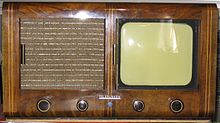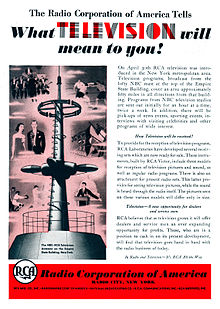441-line television system

441-line is the number of scan lines in some early electronic monochrome analog television systems. Systems with this number of lines were used with 25 interlaced frames per second in France from 1937 to 1956, [1] Germany from 1939 to 1943,[2] Italy from 1939[1] to 1940, as well as by RCA in the United States with 30 interlaced frames per second from 1938 to 1941. Broadcasts were planned in Finland for 1940,[1] but eventually cancelled due to World War II. Some experiments with similar systems were carried out on the USSR in the 1930s[1] and Japan in 1939.[1]
Germany


After trials with a 375-line system during the Berlin Olympic Games of 1936, by 1937 Germany had introduced a 441-line with 50 interlaced fields per second television system that replaced the previous 180 lines network relayed by a special Reichspost (National Post Office) cable network in the country's main cities (Berlin, Hamburg, Munich, Bayreuth, Nuremberg). The system's line frequency was 11.025 kHz and the broadcast frequencies were 46.0 MHz for vision and 43.2 MHz for sound, using a 4 MHz channel bandwidth.[2] Its image aspect ratio was close to 1.15:1.
A project began in 1938 involving the National Post and several companies including Bosch, Blaupunkt, Loewe,[3] Lorenz, TeKaDe[4] and Telefunken[5][6] that aimed to produce 10,000 receivers for the television system.
Telefunken marketed the FE VI, announced in 1936, with a 26 x 21 cm screen and a tuning range of 38-60 MHz..[6][7] The next year, 1937, the FE-VI was introduced, with a larger 50 x 40 cm screen.[7] In 1938 the TF 1 was released, with a 20 x 17 cm screen and a tuning range of 40-55 MHz.[7]
In 1937 Loewe created the FE-D, with a 24x20 cm screen and a tuning range of 35-55 MHz.[3]
In 1938 TeKaDe created a single model, the FS38, with a 30 x 27 cm screen and a tuning range of 43-52 MHz.[4] Other brands like Fernseh AG also created models like the DE 6, also introduced in 1938, with a 32 x 27 cm screen and a tuning range of 40-53 MHz[8]
A single-channel TV receiver, the Einheitsempfänger was created in 1939.[2] It had a 29 cm (diagonal) screen, and consumed 185 watts when receiving television signals and 60 watts when receiving audio only.[2] Only a few units were built before the outbreak of World War II.
Due to the onset of the Second World War only about 50 devices were installed in military hospitals and various government departments. The transmitter's aerials in Berlin were destroyed during an Allied Forces' bombing in November 1943, but the station was also relayed by a special coaxial cables network to "wide screen" public "TV-rooms" (Fernsehstuben) so it carried on this way until 1944.
| System | Lines | Frame rate | Field frequency | Active picture | Field blanking | No. of broad pulses | Broad pulse width | Front porch | Line sync | Back porch | Active line time | Video/syncs ratio | Channel bandwidth | Visual bandwidth | Sound offset | Vision mod. | Sound mod. | Aspect ratio | Line Frequency |
|---|---|---|---|---|---|---|---|---|---|---|---|---|---|---|---|---|---|---|---|
| 441-line | 441 | 25 | 50 Hz | 383 lines | 29 lines | 8 per field | 36.3 μs | 1.0 μs | 9.0 μs | 6.3 μs | 74.3 μs | 70/30 | 4 MHz | 2 MHz[6] | 2.8 | Pos. | AM | 1.15:1 | 11025 Hz |
France
By 1941 the "Fernsehsender Paris" station transmitted from the Eiffel Tower in Paris using the German 441-line system and its main technical characteristics, while however keeping the previous French 455 lines[1] broadcast frequencies 42 MHz - 46 MHz in use from 1938 to 1940, thus with a larger visual bandwidth than the station operating in Berlin.[10] Television programs were mainly for wounded soldiers of the Wehrmacht occupation troops who recovered in the Greater Paris Area hospitals, but they also included French-language shows. Broadcasts were monitored in the United Kingdom during the Second World War to gather intelligence information from occupied France.
The line frequency was 11.025 kHz with vision broadcast at 46.0 MHz and sound at 42.0 MHz. Aerials were independent for audio and vision at the top of the Eiffel tower, both vertically polarized. No gain being obtained from these pre-war basic aerials, the effective radiated power was only the transmitter's peak one, i.e. 30 kW which enabled a good reception in a radius of 100 km (62 miles) around Paris. As displayed in J.M. Frost's WRTH (World Radio TV Handbook) editions at that time, the transmitter's frequencies (42-46 MHz) were listed as channel "F1" or channel "S" (or "Special" channel) in the European Broadcasting Union's official documents.
After July 1952 the 441-line transmitter was no longer broadcasting separate programs, but simply picked up the national network's picture through an 819 - 441-line "optical converter" (a 441-line camera, slightly out of focus, pointed at an 819-lines monitor equipped with an oval spotlight cathode ray tube). Broadcasts were due to cease on January 1, 1958, as the 819 lines standard had been adopted in 1948 for the national network. However, after a long elections coverage night, most of the 441-line equipment was destroyed by fire on January 3, 1956. It was decided to indemnify the 3,000 owners of remaining 441-line sets and to entitle them to reduced rates for their new 819 lines receivers.
Technical details:[10][1][9][2]
| System | Lines | Frame rate | Field frequency | Active picture | Field blanking | No. of broad pulses | Broad pulse width | Front porch | Line sync | Back porch | Active line time | Video/syncs ratio | Channel bandwidth | Visual bandwidth | Sound offset | Vision mod. | Vestigial sideband | Sound mod. | Aspect ratio | Line Frequency |
|---|---|---|---|---|---|---|---|---|---|---|---|---|---|---|---|---|---|---|---|---|
| 441-line | 441 | 25 | 50 Hz | 383 lines | 29 lines | 8 per field | 36.3 μs | 1.0 μs | 9.0 μs | 6.3 μs | 74.3 μs | 70/30 | 7 MHz | 3 MHz | 4 | Pos. | 3 | AM | 1.15:1 | 11025 Hz |
Italy
Following pre-war tests in 343 lines done by a Turin engineer named Castellani, broadcasts using the 441-line system began in Italy in 1939[1] with regular services from Rome using 2kW power and Milan using 400W of power in the frequency band of 40-45 MHz.[10] As in France technical parameters – VHF frequencies excepted – were identical to those in use in Germany.
Broadcasts were discontinued on May 31, 1940.
United States

In September 1938 the Radio Manufacturers Association (RMA) recommended the 441-line system[11] developed by RCA and Farnsworth Television.[12][13][14][15][16] Tests started a year before, in an attempt to perfect a 343-line system,[13] with RCA executives petitioning the FCC for approval of their new standard.[17] In early 1938 Philco's experimental transmitter W3XE in Philadelphia was already using the system.[11][18][19][16]
TV broadcasts were publicly launched in April 1939 by NBC, during the New York World's Fair, using the W2XBS station.[20] The first pre-built TV receivers were sold on a very limited basis, mostly in New York City. Manufacturers included RCA,[21] General Electric,[22] DuMont,[23] and Andrea Radio Corporation.[24][25]
By June 1939, regularly scheduled broadcasts were available in New York and Los Angeles. By October nineteen TV broadcast licenses had been issued, including stations in New York, Philadelphia (W3XE), Chicago, Washington, Fort Wayne, Cincinnati, Schenectady (W2XB), Los Angeles and San Francisco.[20] By November General Electric's station in Schenectady started broadcasts.
W2XBS in New York broadcast up to fifty-eight hours of programming per month until December 1939, to an estimate of 2,000 receiving sets. Reception area was a radius of 40-50 miles (80 km) from the Empire State Building.[26]
Following a decision of the NTSC (National Television System Committee), the 525-line standard replaced the 441-line standard on July 1, 1941.[27]
Technical details:[11]
| System | Lines | Frame rate | Field Frequency | Channel bandwidth | Visual bandwidth | Sound offset | Vision mod. | Sound mod. | Aspect Ratio | Line frequency |
|---|---|---|---|---|---|---|---|---|---|---|
| 441-line | 441 | 30 | 60 Hz | 6 MHz | 2.8 MHz | 3.25 | Neg. | AM | 4:3 | 13230 Hz |
Soviet Union
In the Soviet Union a specification for a 441-line format at 25 fps interlaced was developed in 1940. This was developed from broadcasts and tests started in 1937 from Moscow, using the older 343-line system, based on RCA equipment.[28] Due to WWII the 441-line system never reached the broadcast stage.
References
- ^ a b c d e f g h "405 Alive - FAQ - 405-Line Television in History". www.bvws.org.uk.
- ^ a b c d e f "Einheits-Fernseh-Empfänger E l" (PDF). aobauer.home.xs4all.nl. pp. 320–321. Archived (PDF) from the original on 28 March 2022.
- ^ a b "D. S. Loewe Prewar Sets". www.earlytelevision.org.
- ^ a b "Gerolf Poetschke's Site". www.earlytelevision.org.
- ^ "Telefunken FE-VI". www.earlytelevision.org.
- ^ a b c "FE VI Television Telefunken Deutschland TFK, Gesellschaft für, build". www.radiomuseum.org.
- ^ a b c "Telefunken Prewar Sets". www.earlytelevision.org.
- ^ "Gerolf Poetschke's Site". www.earlytelevision.org.
- ^ a b "R.T.Russell: Colour Test Card Generator". bbcbasic.uk.
- ^ a b c "Prewar European Stations". www.earlytelevision.org.
- ^ a b c Murray, Albert (1938). "RMA Completes Television Standards" (PDF). Electronics (July): 28.
- ^ Fink, Donald (1938). "A LABORATORY TELEVISION RECEIVER" (PDF). Electronics (July): 16.
- ^ a b "Recent Progress in Television Technique" (PDF). Proceedings of the Radio Club of America. 17, No.1 (February). 1940.
- ^ "RCA'S FIRST ICONOSCOPE CAMERAS & THE PROTOTYPE". Eyes Of A Generation…Television's Living History.
- ^ Edgerton, Gary Richard (June 21, 2007). The Columbia History of American Television. Columbia University Press. ISBN 9780231121651 – via Google Books.
- ^ a b Abramson, Albert (June 27, 1955). "Electronic Motion Pictures". University of California Press – via Google Books.
- ^ Alexander B. Magoun, Television: The Life Story of a Technology. Greenwood, p. 65. ISBN 978-0313331282.
- ^ "The Deseret News - Google News Archive Search". news.google.com.
- ^ "Network TV". www.aes-media.org.
- ^ a b Burns, R. W. (June 21, 1998). Television: An International History of the Formative Years. IET. ISBN 9780852969144 – via Google Books.
- ^ "Early Electronic Television - RCA". Early Television Museum.
- ^ "Early Electronic Television - General Electric". Early Television Museum.
- ^ "Early Electronic Television - DuMont". Early Television Museum.
- ^ "Early Electronic Television - Andrea Radio Corp". Early Television Museum.
- ^ Pine, Arthur (1950). "Frank Andrea - Radio and Television Pioneer" (PDF). Radio and Television News (May): 40.
- ^ Lohr (1940)
- ^ "The following are random notes about". www.tech-notes.tv.
- ^ "Participation of A.Raspletin in developing and realization of black-and-white television standards".
Bibliography
- Lohr, Lenox (1940). Television Broadcasting. New York: McGraw Hill.
External links
- (in German) Rolf Wigand: Technische Beschreibung des E 1 (Zeitgenössischer Artikel in „Radio-Mentor", pdf 295 kB)
- (in German) Eckhard Etzold: Ausführliche Webseite mit vielen Fotos sowie Schaltbild des E 1
- http://www.compulink.co.uk/~rrussell/tccgen/manual/tcgen0.html
- American Early Television Museum : pre-WWII TV-stations in Europe
